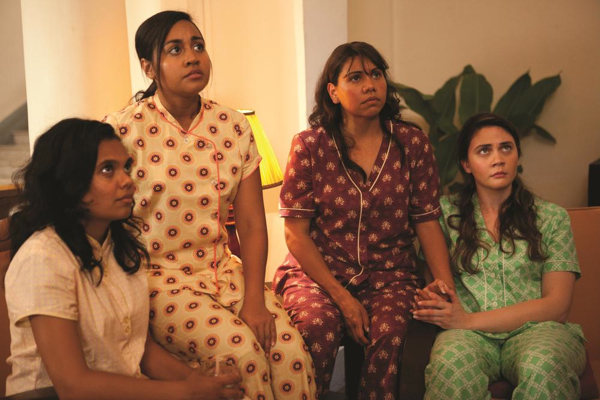Movie review by Greg Carlson
Very loosely based on the story of a singing group of Aboriginal women who performed for soldiers during the Vietnam War, “The Sapphires” depends on the charm and wit of Chris O’Dowd and the catchy soul tunes made famous by Linda Lyndell, the Staple Singers, the Four Tops, and others to overcome the film’s marshmallow structure and simplistic historical reductionism. Director Wayne Blair paints the characters in extremely broad strokes, falling back on the use of single, repeated traits to differentiate among the principal players, but the exuberance of the music and the heartwarming uplift will win over many.
Originally produced as a stage play written by Tony Briggs, whose mother was one of the women who inspired the drama, “The Sapphires” introduces Australian sisters Gail (Deborah Mailman, who played younger sis Cynthia onstage) and Cynthia (Miranda Tapsell) as a duo keen on performing country music in backwater talent competitions. Soon, youngest sibling Julie (Jessica Mauboy) emerges – to the dismay of bossy Gail – as the most talented vocalist in the family. As a single mother who for unknown reasons keeps secret the identity of her little boy’s father in a storyline that goes nowhere, Julie should have been constructed with greater care and detail, especially in the rendering of her decision to temporarily leave her child.
O’Dowd’s boozy promoter Dave Lovelace is initially painted as a potentially untrustworthy opportunist who sees in the Cummeragunja Songbirds a chance to pursue both R&B passions and financial gain. To the film’s credit, we are spared at least one classic ne’er do well cliché when Dave doesn’t squander the group’s earnings during a drunken card game. Instead, the narrative uses Dave’s borderline substance abuse as a conflict trigger in his budding romance with Gail. Both the color of O’Dowd’s skin and his unlikely nationality are mined for jokes, but the character’s affinity for Otis Redding and Wilson Pickett is as earnest as the same kind of ardor displayed by the working class Dubliners in Alan Parker’s infectious 1991 adaptation of Roddy Doyle’s “The Commitments.”
Capitalizing on the parallels between the African-American Civil Rights Movement and the discrimination faced by indigenous Australians through the institutionalized removal of Aboriginal children from their families, “The Sapphires” addresses racism and the horror of legally sanctioned kidnapping in one of its arcs. The story of the fourth Sapphire, Kay (Shari Sebbens), deals with the young woman’s identity as a mixed-race victim of the removal policy. Viewers will be reminded of Phillip Noyce’s 2002 movie adaptation of “Rabbit-Proof Fence,” the best-known feature to cover the Stolen Generations.
The pain caused by the childhood theft and forced adoption of Kay fuels Gail’s feelings of anger, guilt, and resentment, and the subplot is one of the movie’s most emotionally satisfying components. The relationship dynamics between the two women might have served as the basis for a fully-fledged movie on its own. As it stands, “The Sapphires” spends more time on the eye-opening adventures that accompany a theater of war, and in spite of the film’s modest budget, the limited location photography in and around Ho Chi Minh City evokes the period detail of the Vietnam War.
